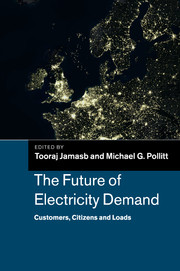Book contents
- Frontmatter
- Contents
- List of Figures
- List of Tables
- List of Boxes
- List of Contributors
- Foreword
- Preface
- Acknowledgements
- Introduction and overview of the chapters
- Part I The economics
- Part II Technology
- Part III Social dimensions
- Part IV Policy and regulation
- 14 Demand-side management strategies and the residential sector: lessons from the international experience
- 15 Electricity distribution networks: investment and regulation, and uncertain demand
- 16 The potential impact of policy and legislation on the energy demands of UK buildings and implications for the electrical network
- 17 The ADDRESS European Project: a large-scale R&D initiative for the development of active demand
- 18 Daylight saving, electricity demand and emissions: the British case
- 19 Concluding reflections on future active networks and the demand-side for electricity
- Index
- References
14 - Demand-side management strategies and the residential sector: lessons from the international experience
from Part IV - Policy and regulation
Published online by Cambridge University Press: 05 March 2014
- Frontmatter
- Contents
- List of Figures
- List of Tables
- List of Boxes
- List of Contributors
- Foreword
- Preface
- Acknowledgements
- Introduction and overview of the chapters
- Part I The economics
- Part II Technology
- Part III Social dimensions
- Part IV Policy and regulation
- 14 Demand-side management strategies and the residential sector: lessons from the international experience
- 15 Electricity distribution networks: investment and regulation, and uncertain demand
- 16 The potential impact of policy and legislation on the energy demands of UK buildings and implications for the electrical network
- 17 The ADDRESS European Project: a large-scale R&D initiative for the development of active demand
- 18 Daylight saving, electricity demand and emissions: the British case
- 19 Concluding reflections on future active networks and the demand-side for electricity
- Index
- References
Summary
Introduction
Policies and measures targeting energy demand took off over the last three decades in response to the oil shocks of the 1970s. Since then, concerns about the sensitivity of economies to energy prices, oil dependency and more recently climate change, contributed to the development of energy efficiency (EE) policies. Demand-related policies that aim to influence quantities or patterns of energy use have traditionally been referred to as demand-side management (DSM) programmes. They include both energy efficiency policies and demand response (DR). Energy efficiency improvements can bring many benefits in terms of reduced energy infrastructure investments, decrease in electricity prices, increased energy security, improved environmental quality and other ancillary benefits. Scientists estimate that by 2050, we will need to have reduced our greenhouse gas emissions (GHG) by 50 per cent to avoid the worst-case scenarios of climate change. In such a context, the building sector appears as the ‘cornerstone of every national climate change strategy’, as it is responsible for up to 30 per cent of global annual GHG emissions, and 40 per cent of all energy consumption (UNEP, 2009). Furthermore, there is widespread evidence of the cost-effectiveness of energy efficiency measures as compared to renewable programmes (IEA, 2006). In parallel, load growth; increased intermittency due to renewable generation; and, in the UK in particular, the renewal and reconfiguration of the electricity network pose challenges to the electricity sector never seen before. These challenges increasingly lead to the recognition of the importance of active consumer participation in load shifting, and hence interest in influencing quantities or patterns of energy demand.
There is now substantial experience particularly among OECD countries in using policy instruments to improve the overall efficiency with which energy is used. Several recent studies have assessed these experiences. For example, Geller et al. (2006) review energy intensity trends in the OECD from 1973 to 2003. They focus on the specific policies adopted by Japan, the US and a selection of European countries to improve energy use per unit of GDP across sectors. The World Energy Council (WEC) has conducted a review of energy efficiency policies using a survey of seventy countries, including examples of the most effective types of policy measures (WEC, 2008). Similarly, the United National Environment Programme Sustainable Buildings & Climate Initiative (UNEP-SBCI) published several reports assessing the implemented policies in various countries. A number of International Energy Agency (IEA) publications have also looked at energy use trends (IEA, 2007; IEA, 2008); reviewed the implementation of energy efficiencies policies in general (IEA, 2009b); and in the residential sector in particular (IEA, 2008).
- Type
- Chapter
- Information
- The Future of Electricity DemandCustomers, Citizens and Loads, pp. 337 - 378Publisher: Cambridge University PressPrint publication year: 2011
References
- 12
- Cited by



